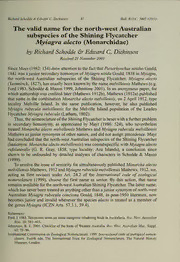
The valid name for the north-west Australian subspecies of the Shining Flycatcher Myiagra alecto (Monarchidae) PDF
Preview The valid name for the north-west Australian subspecies of the Shining Flycatcher Myiagra alecto (Monarchidae)
RichardSchodde& EdwardC Dickinson 47 Bull. B.O.C. 2005 125(1) The valid name for the north-west Australian subspecies ofthe Shining Flycatcher Myiagra alecto (Monarchidae) & by Richard Schodde Edward C. Dickinson Received21 November2003 SinceMees (1982: 134) drewattentiontothe factthatPiezorhynchusnitidusGould, 1841 was ajunior secondary homonym ofMyiagra nitida Gould, 1838 inMyiagra, the north-west Australian subspecies of the Shining Flycatcher, Myiagra alecto (Temminck, 1827), hasusuallybeenknownbythename melvillensisMathews (e.g. Ford 1983, Schodde & Mason 1999, Johnstone 2001). In an anonymous paper, for which authorship was credited later (Mathews 1912b), Mathews (1912a) published that name in the combinationMonarcha alecto melvillensis, on 2 April 1912, type locality Melville Island. In the same publication, however, he also published Myiagra rubecula melvillensis for the Melville Island population of the Leaden FlycatcherMyiagra rubecula (Latham, 1802). Thus,thenomenclatureofthe ShiningFlycatcherisbesetwithafurtherproblem in secondary homonymy, as appreciated by Mayr (1986: 524), who nevertheless treated Monarcha alecto melvillensis Mathews and Myiagra rubecula melvillensis Mathews asjunior synonyms ofothernames, and did not assignprecedence. Mayr had concluded that the north-westAustralian subspecies ofthe Shining Flycatcher (basionym: Monarcha alecto melvillensis) was consubspecific withMyiagra alecto rufolateralis (G. R. Gray, 1858, type locality: Aru Islands), a conclusion since shown to be unfounded by detailed analyses of characters in Schodde & Mason (1999). To resolve the issue ofseniority for simultaneouslypublishedMonarcha alecto melvillensisMathews, 1912 andMyiagrarubeculamelvillensisMathews, 1912,we, acting as first revisers under Art. 24.2 of the International code ofzoological nomenclature (1999), choose the first name as senior. By this action, that name remains available forthenorth-westAustralian ShiningFlycatcher.The lattername, whichhasneverbeentreatedas anything otherthanajuniorsynonymofnorth-west Australian Myiagra rubecula concinna Gould, 1848, in post-1950 literature, now becomesjunior and invalid whenever the species alecto is treated as a member of the genus Myiagra (ICZNArts. 57.3.1, 59.4). References: Ford,J. 1983.Taxonomicnotesonsomemangrove-inhabitingbirdsinAustralasia.Rec. West.Australian Mus. 10: 381-415. Johnstone, R. E. 2001. Checklist ofthe birds ofWesternAustralia. Rec. West.Australian Mus., Suppl. 63: 75-90. InternationalCommissiononZoologicalNomenclature. 1999.Internationalcodeofzoologicalnomen- clature. Fourth edn. The International Trust for Zoological Nomenclature, The Natural History Museum,London. RichardSchodde&EdwardC. Dickinson 48 Bull. B.O.C. 2005125(1) Mathews,G.M. 1912a.AdditionsandcorrectionstomyReferenceListtothebirdsofAustralia.Austral AvianRecord 1: 25-52. Mathews, G. M. 1912b. Editorialnotice.AustralAvianRecord1: 65. Mayr, E. 1986. Monarchidae. In Watson, G. E.,Traylor, M.A. & Mayr, E. (eds.) Check-listofbirdsof theworld,vol. 11. Mus. Comp.Zool., Cambridge,MA. Mees, G. F. 1982. Birds from the lowlands ofsouthern New Guinea (Merauke and Koembe). Zool. Verhand., Leiden 191. Schodde, R. & Mason, I. J. 1999. The directory ofAustralian birdspasserines. CSIRO Publishing, Melbourne. Addresses:RichardSchodde,AustralianBiologicalResourcesStudy,GPOBox787,CanberraCity,ACT 2601,Australia, e-mail: [email protected]. Edward Dickinson, TheTrust for Oriental Ornithology,Flat3,BolsoverCourt, 19BolsoverRoad,EastbourneBN207JG,UK. ©BritishOrnithologists'Club2005 The taxonomic status ofthe three subspecies of Cuculus saturatus by Ben King Received3January 2004 Cuculus horsfieldi Moore 1857, Cuculus saturatus 'Hodgson' Blyth 1843, and Cuculus lepidus S. Miiller 1845, were all originally described as species. However, Peters (1940) placed C. horsfieldi as a subspecies ofC. saturatus and C. lepidus as a subspecies of C poliocephalus Latham 1790. Wells & Becking (1975) demonstrated that lepidus was more closely related to C. saturatus, based on its song, which they described and illustrated with sonograms. A classification ofC. saturatus consistingofthree subspecieswas generallyfollowedintothe 1990s, e.g., by Sibley & Monroe (1990), Howard & Moore (1991) andWells (1999). However C Payne (1997) considered C. horsfieldi a species separate from saturatus, based on differences in their songs, which he described. Clements (2000) followed this split. The breeding ranges ofthe three forms ofCuculus saturatus are allopatric. C. (s.) horsfieldi breeds across northern Eurasia from north-east Europe to Japan and C north-east China. (s.) saturatus breeds across the Himalayas, southern China, Taiwan and the extreme northernpart ofsouth-eastAsia. C. (s.) lepidus is resident C C in Malaya, and the Greater and Lesser Sunda Islands. (s.) horsfieldi and (s.) saturatus winter from southern India east and south to New Guinea andAustralia. Recent field work and museum study suggests that the taxonomic status ofthese forms should be revisited.
